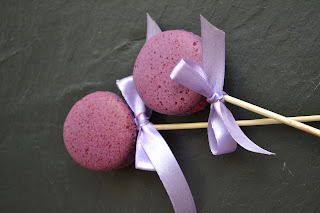 |
| The Lenotre class |
I'm back and finally rested from a pretty intense trip to Lenotre, but it was worth the aching feet. I got to Paris Tuesday evening, and then took the train up to Plasier, which is where the Lenotre factory is based. Plasier is a tiny little town surrounded by farmland and factories. Lenotre, I found to my dismay, was further away, so it took me a while of hand gesturing, queuing in the wrong lane, getting soaked in the rain, before I finally managed to find the right bus that dropped me at my motel near Lenotre. Now I am being generous when I say motel - scary, smelly rooms from the set of The Evil Dead might be more near the mark. When I went into the lobby/bar to get my key, I realized I was the only female around, everyone else was male and dressed up in black trench coats!! I slept with the TV on.
The Lenotre University, which is based inside their factory, is one of the first proper pastry schools in France. It runs professional classes and courses for bakers and pastry chefs from around the world. In fact Pierre Herme, the Karl Lagerfield of the pastry world, was one of its alumni -or so Ive been told.
 |
| Rosemary Macaron |
The next morning class started at 8 a.m. The chef Gerard was an MOF, which is one of the greatest honours of the food world.( It is like being knighted for services to food in France).He walked us through the basic macaron recipe and then put us to work. That day we made macarons for 11 hours straight!! My feet were aching, but the good thing was I was too exhausted to care about axe wielding murderers and slept like a log.
 |
| Salted Caramel macarons | |
|
|
We made macarons using a French meringue, which is a technique I have been using. It is more fiddly and difficult than the Italian meringue but the end results are a more shiny macaron. The first step is to make a TPT, which is equal parts sugar and almonds, which is then sifted through a tamis.
 |
| Raspberry Macarons |
The eggs are beaten to a froth, the sugar is added slowly to the mix so that it becomes a glossy, shiny meringue. I was told off for adding the sugar too early. Patience is a virtue, I was told!
 |
| Ginger Macarons |
The macarons are then piped out in neat little circles. Since piping is one of my weakest points, the chef made me pipe and pipe and pipe till I got the little buggers right. "Hold the bag straight and flick," he shouted. "Fleeeek!"
 |
| Tonka Beans |
The piped macarons are then put in the oven. The first time the chef realized too late that someone had filled the industrial oven with water (don't ask why) so that the first batch of macarons came out looking like dog poo. A lot of cursing in French followed.
 |
| Mixed Fruit macaron |
The macarons were finally baked at a high temperature for five minutes to form the little feet, then the temperature was lowered. One of the best parts of the lesson was learning how to get the macarons off the baking sheets, which believe me is not an easy task. All you do is fill a big mug with water, lift the baking sheet and splosh the tray with water. The steam helps release the macarons from the sheet. (I have a photograph somewhere of the soaking wet sheets, Ill add it later).
 |
| Hollandaise | | | |
. |
| Amaretti |
We also made different kinds of macarons, from Italian style Amaretto biscuits to Hollandaise, which are a very crunchy, almondy rustic cousin of the more refined Macaron.
 |
| Our final day presentation |
After the course finished I went back to Paris for a day and a half and ate my way through all the more famous macaron shops. Ialso bought a lot of ingredients that we don't find here, from the finest Spanish almonds to organic food colouring. I had to buy another suitcase to fit everything in!
Back in the UK, as I struggled down the Eurorail a guy behind me quipped "Oooh, smuggling the kitchen sink are we?!" I was home again.

































